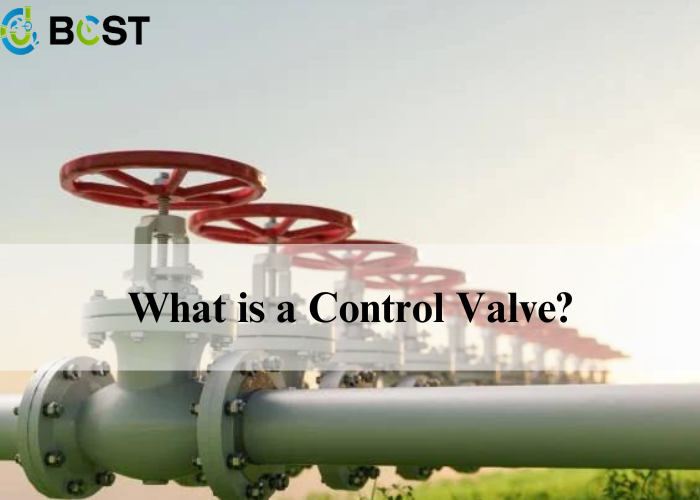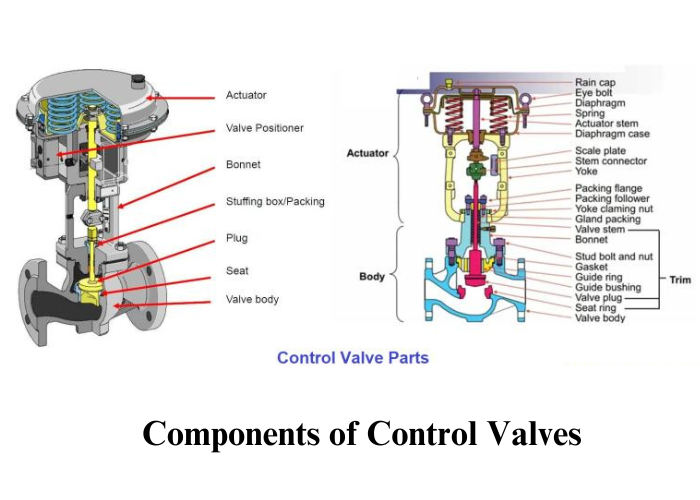
Control valves are essential components in industrial automation systems, primarily comprised of electric or pneumatic actuators and valve bodies. They regulate the flow of media during processes to meet changes in loads or operating conditions. This article will discuss the types, components, and significance of control valves.
In industrial control systems, there are two common types: linear and rotary control valves, which play crucial roles in fluid control.
Linear Control Valves
Linear control valves are a common type, categorized into single-seated and double-seated varieties.
Single-seated Control Valves
Single-seated control valves have a simple structure consisting of valve bodies, valve cores, valve seats, actuators, etc. Their features include:
- Compact structure, small volume, suitable for limited spaces.
- High adjustment accuracy, fast response speed, suitable for applications with strict requirements on parameters such as flow rate and pressure.
- Suitable for small to medium flow rates, commonly used for controlling water, steam, gas, and other media.
Double-seated Control Valves
Double-seated control valves are an improvement over single-seated ones, characterized by:
- The adoption of a double-seated structure, ensuring the valve operates independently of medium pressure, with good sealing performance.
- Large circulation capacity, suitable for high flow rate applications.
- Low unbalanced force, stable operation, suitable for situations with high pressure drops and low leakage requirements.
Rotary Control Valves
Rotary control valves are another common type, including V-type electric ball valves, pneumatic control valve diaphragm globe valves, and eccentric butterfly valves, among others.
V-type Electric Ball Valves
V-type electric ball valves are structurally simple and operationally flexible control valves, featuring:
The ball valve structure with low fluid resistance, providing good flow regulation performance.
- Suitable for applications with high viscosity and high particle content, such as the chemical and pharmaceutical industries.
- Precise flow control and stable control effects achieved by controlling the valve core position through electric actuators.
Pneumatic Control Valve Diaphragm Globe Valves
Pneumatic control valve diaphragm globe valves adopt a diaphragm structure, with the following features:
- Simple structure, reliable sealing, suitable for applications with strict leakage requirements.
- Convenient pneumatic actuator operation, enabling quick response and stable control effects.
- Suitable for highly corrosive media and high-temperature applications, such as the chemical and metallurgical industries.
Eccentric Butterfly Valves
Eccentric butterfly valves utilize an eccentric structure, characterized by:
- Simple structure, small size, and easy to install and maintain.
- Wide range of flow rate adjustment and rapid response speed.
- Suitable for high flow rate and medium to low-pressure applications, such as water supply and drainage systems.
Components of Control Valves

Control valves consist of actuation mechanisms and valve bodies. The actuation mechanism propels the valve and adjusts the fluid flow based on signal pressure. This displacement subsequently actuates the valve core, enabling fluid regulation control. Pneumatic actuation mechanisms are a common type, known for their simple structure, reliable operation, ease of maintenance, and low cost, hence their widespread usage.
Pneumatic diaphragm actuators are a common form of pneumatic actuation mechanism. In pneumatic control valves, they can produce forward and reverse effects, corresponding to the states of air-open and air-close. Their working principle is as follows: In the forward effect, the air source enters the diaphragm chamber through the upper diaphragm cover, exerting pressure on the diaphragm, compressing the spring on the tray, thereby pushing the push rod downward, achieving valve core opening.
Installation and Application Notes
Installation and use of pneumatic control valves can accomplish production processes through simple manipulation. This type of device is highly responsive and can achieve high reaction speeds after installation. Moreover, the device is safe and convenient to use during operation, leading to increasing attention from users regarding the installation and application of control valves.
Proper Installation Methods
To achieve better application purposes during the installation and use of pneumatic control valves, attention should be paid to whether the installation method of the product is reasonable. The installation effect directly influences the actual application. When installing and using control valves, it’s important to maintain a certain distance from the ground. If the control valve is installed too close to the ground, it will be inconvenient for maintenance operations. Maintaining a reasonable distance from the ground can provide convenient conditions for maintenance operations and also comply with the installation specifications of the device.
Correct Installation Steps
Self-operated control valves and pneumatic control valves need to be securely installed on horizontal pipelines, maintaining verticality. Additionally, fixed support operations need to be conducted at the valve position to achieve installation standards by adjusting the distance of the valve. To facilitate the use of control valves, personnel should also be careful not to add stress to the valves, as this can affect the valve’s smooth operation.
Requirements of Application Environment
Furthermore, the application environment for control valves should not have excessively high temperatures, and humidity should meet standards. Excessive temperature or humidity beyond the standard range will adversely affect the application of control valves. Proper environmental conditions ensure the stable operation and prolonged lifespan of control valves.
Role and Importance of Control Valves in the System
Role of Control Valves
Control valves are an indispensable component of industrial automation systems, often referred to as the “hands and feet” of process automation. They play a crucial role in regulating the flow of media in industrial production processes, directly influencing the quality and stability of systems.
Pneumatic control valves (also known as pneumatic actuators) operate on compressed air as a power source. They are characterized by simple structure, reliable operation, stable performance, low cost, easy maintenance, fire and explosion resistance, etc. They can be used not only in combination with pneumatic control instruments and pneumatic unit combination instruments but also can be matched with electric control instruments and electric unit combination instruments through electric-pneumatic converters or electric-pneumatic valve positioners. They are widely used in chemical, petroleum, metallurgy, power plants, textile, and other industrial sectors.
Due to the simple structure of control valves, they are often overlooked, which is noteworthy. Control valves are directly installed on process pipelines and operate under harsh conditions such as high temperature, high pressure, deep freezing, extreme toxicity, flammability, explosiveness, permeability, crystallization, strong corrosion, and high viscosity. Their quality directly affects the system. Improper selection or inadequate maintenance can lead to problems. For example, some control loops are unstable and oscillate continuously. If improvements are made in the selection, changing the linear characteristic valve core to a logarithmic characteristic valve core or changing the flow direction can greatly improve the quality of regulation. Furthermore, some continuous oscillations during the regulation process are not due to excessive or insufficient proportional degrees of the regulator but rather due to excessive dry friction in the valve stem packing box, making the action very sluggish. Additionally, valve leakage will cause pollution in the factory area and even accidents. Therefore, the role of control valves should be emphasized, and maintenance and upkeep should be strengthened.
The Importance of Control Valves
- Control valves are throttling valve devices belonging to the category of moving components. In comparison with detection elements, transmitters, and controllers, control valves continuously alter the throttling valve’s flow area during the control process to adapt to changes in load or operating conditions, thereby adjusting control variables. Consequently, higher demands are placed on the sealing, pressure resistance, and corrosion resistance of control valve assemblies. For instance, sealing increases friction and dead zone of control valves, leading to poor control quality in control systems.
- Control valves demonstrate strong adaptability as they are installed in various production processes where high temperatures, low temperatures, high pressures, large flow rates, and small flow rates are encountered. Different functions are required of control valves to meet the demands of various applications in different operating conditions.
- The throttling action of control valves consumes energy. Therefore, it is essential to make a rational choice considering the trade-offs between reducing energy consumption, decreasing pressure losses across control valves, and ensuring better control quality. The contact medium for control valve materials may differ from that of test elements, hence imposing higher requirements on the corrosion resistance, strength, and rigidity of control valves.
- Control valves also generate noise during throttling. For example, flashing occurs when the outlet pressure of the control valve is lower than the vapor pressure of the liquid, while cavitation arises when the downstream pressure of the control valve exceeds the vapor pressure of the liquid. The noise produced by control valves is related to the design of the control valve flow path, operating pressure, and characteristics of the controlled medium. Consequently, higher demands are placed on control valves concerning noise reduction and pressure loss reduction.
Conclusion
Generally speaking, the selection of control valves is the first step in ensuring the proper operation of a system. Factors such as fluid medium, operating pressure, temperature range, and flow requirements should be considered during the selection process. Choosing suitable materials and models is crucial for the long-term stable operation of the system.
The installation of control valves also requires careful design and execution. The appropriate installation position, correct installation orientation, and tight connections are key to ensuring the normal operation of valves. Moreover, attention must be paid to sealing and leakage issues to prevent system leaks or unstable pressure.
Maintenance is an essential aspect of ensuring the long-term effective operation of control valves. Regular inspections and maintenance can ensure the normal operation of valves and extend their service life. This includes cleaning, lubrication, checking seals, and replacing worn parts. Only through proper maintenance can control valves maintain the stability and efficiency of the system.
In conclusion, control valves play a crucial role in industrial production, and their selection, installation, and maintenance require careful attention to ensure the stability and efficiency of system operation. Only through careful management and maintenance can control valves fulfill their maximum potential and provide assurance for the smooth operation of industrial production.






